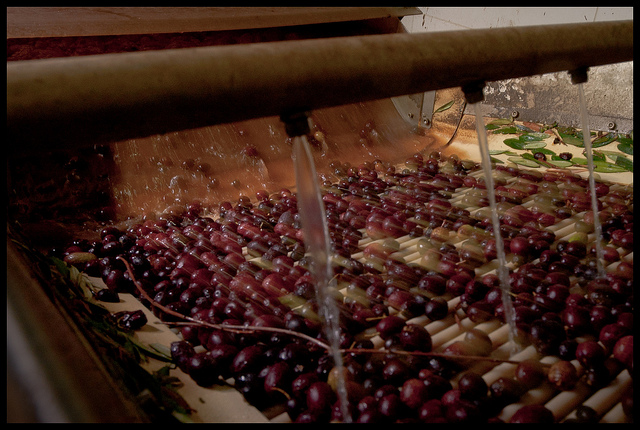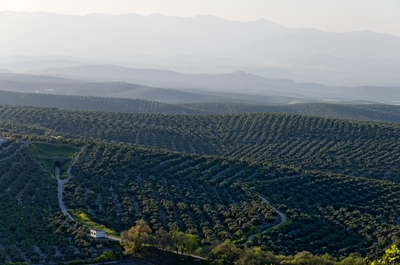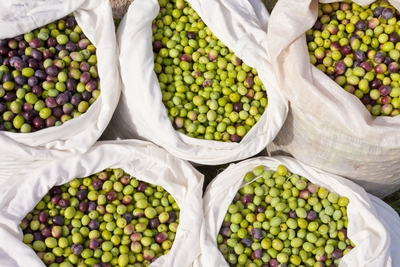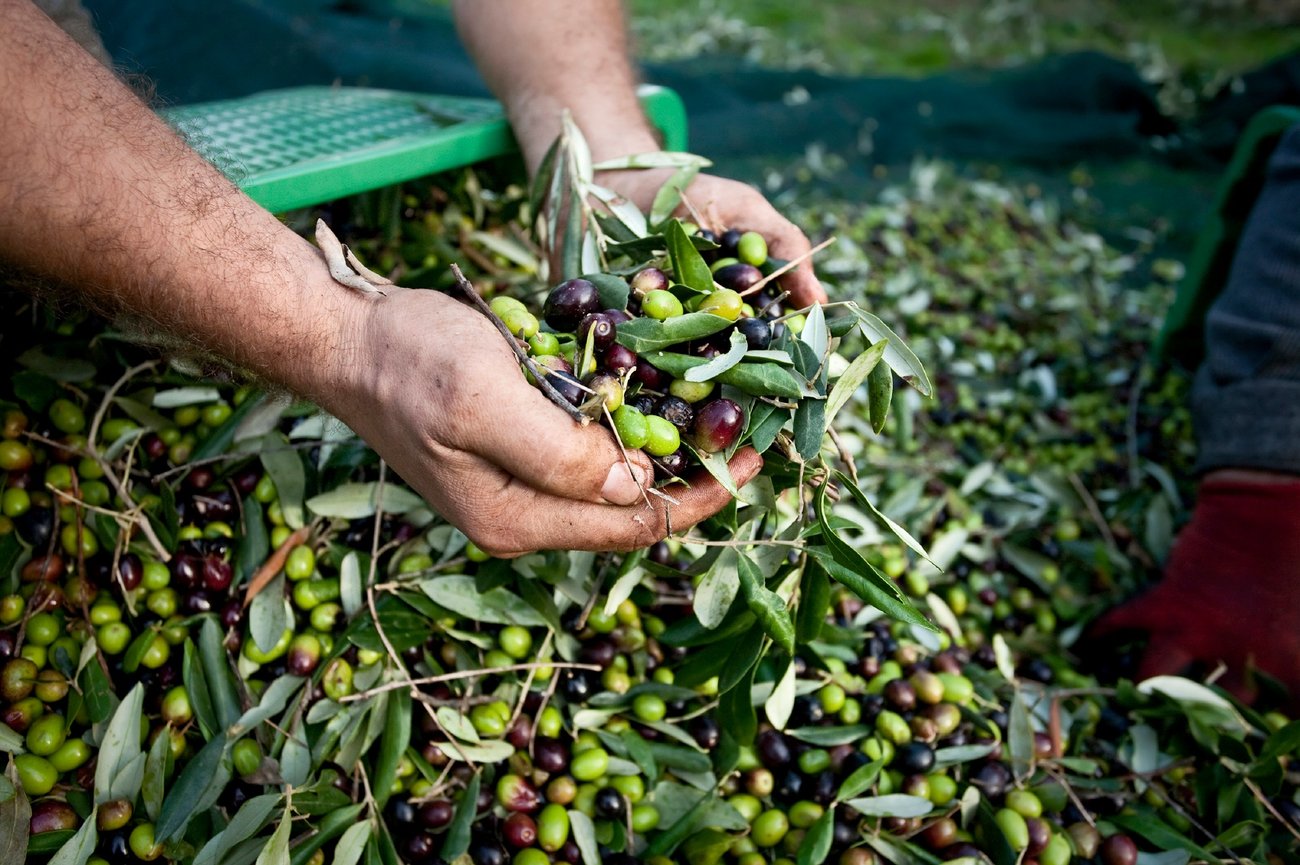You walk into a gourmet olive oil store: in front of you, there is Spanish olive oil, there’s Greek olive oil, and there’s Italian olive oil — along with oil from about about 20 other countries. So what is it about each of these regions that gives the olives their particular flavor?

Let me ask the question a different way… If you cut an olive tree in half, roots and all, and took 1/2 to Spain and 1/2 to Greece, would the Extra Virgin Olive Oil, once produced, taste different?
This musing probes at the root of a bigger question: why do particular olive growing regions have distinctive flavors of EVOO? Why is the classic Spanish EVOO peppery? Why does Tunisian EVOO taste buttery?
This is a more complex question than it may seem at first glance, because there’s a few different factors that make an olive oil taste the way it does: olive varietal, regional climate, weather affecting growth, and ripeness at the harvest.
Olive Varietals

The varietal (think of it as a type or breed) of olive is the most influential part that makes up the flavor of an olive oil. Some varietals of olive taste bitter, some taste peppery, some taste buttery, some taste grassy. And when combined and blended together, they can form new flavors and tastes (think of flavors reminiscent of cucumber, green grass, tomato, cantaloupe, etc.) You can see a good list of the different flavors you can use to describe EVOO here.
There are hundreds of varietals of olives around the world. The Olive Oil Source has a good list of most of these varietals along with the common origins here.
Regional Climate
 The climate in a particular country or area can affect how the olive oil tastes.
The climate in a particular country or area can affect how the olive oil tastes.
Things that contribute to this are the moisture in the air, the moisture in the soil, the altitude and the make-up of the soil (aka, the minerals and salts available for the tree to absorb). So even if you were to take the same varietal and plant it in two different regions, you may get a slightly different flavor.
Olive Ripeness At Harvest
 When a tree of olives is ripening, not all of them ripen at the exact same time on the exact same tree. This is similar to an apple orchard (something more of us here in the US are familiar with) — most apples will be harvested within the same month or two, but it depends on the type of apple. Some will be ready sooner, some later; it will all depend on the weather and the bees and the flowering. And even on the same tree, some apples will be ready to pick sooner than others. And so it goes with olives.
When a tree of olives is ripening, not all of them ripen at the exact same time on the exact same tree. This is similar to an apple orchard (something more of us here in the US are familiar with) — most apples will be harvested within the same month or two, but it depends on the type of apple. Some will be ready sooner, some later; it will all depend on the weather and the bees and the flowering. And even on the same tree, some apples will be ready to pick sooner than others. And so it goes with olives.
The thing is that with olives, because they are smaller, they aren’t harvested by plucking one at a time as they become ripe. They are harvested in clusters, as a set of trees is deemed ready to harvest. This is the same no matter if the harvest is done by hand or by machine.
(By the way, this is still a debated point, whether hand harvesting or machine harvesting helps to preserve the quality of the oil more. The consensus seems to be leaning towards machine harvested to the olives from tree to mill faster and keep them out of the sun — which causes oxidization. Team-“hand-picked” sites far less olive bruising — which also causes oxidation — because of their gentle combing and large collecting nets to harvest the olives from the trees as their own up-side. I say you win some you loose some. Side tangent!)
Needless to say, when the olives are harvested, they are often a mix of olives showing a mix of ripeness, with the goal to come to an ideal average based on what flavor profile the farmer is going after. They are a typically a mix of green all the way to purple olives. Across the board, it’s common that olives that are less ripe will be more bitter, while the more ripe olives will have a more mild, buttery flavor profile.

Changes From Year To Year
To complicate things even more, you could see the same sort of differences from one crop year to another as the weather and soil changes yearly.
So it’s very challenging to control this part, even if you limit your supply search to a particular source, a set of trees, or a blend of olives, you may see some small changes from lot to lot, simply because it’s a natural product.
The Good News For Manufacturers
 The good news for food manufacturers in all of this, is that when related to your industry in particular, we are “nit-picking”. We are noticing the very slight flavor profile shifts that you can taste in an Extra Virgin Olive Oil.
The good news for food manufacturers in all of this, is that when related to your industry in particular, we are “nit-picking”. We are noticing the very slight flavor profile shifts that you can taste in an Extra Virgin Olive Oil.
Usually, an untrained pallet may be able to just detect these slight flavor differences if they drink each origin of EVOO by itself and compare them side-by-side. When you eat that EVOO on a cold salad, you might still be able to taste some of the major shifts in flavor — depending on how many other flavors you have included. But it would be tougher.
But if you are using EVOO as an ingredient in a more complex or cooked food like bread, frozen meals, or robust dips (like most manufacturers ARE), these flavor profile discussions are going to be very minor. Do a taste test — chances are that you won’t be able to taste the difference between origins once it’s integrated into a product.
This makes life a bit easier for you by opening up the supply chain and providing a bit more risk protection and supply chain security, as well as lower pricing when the market rises. This allows you and your suppliers to source strategically.
Topics: Olive Oil












